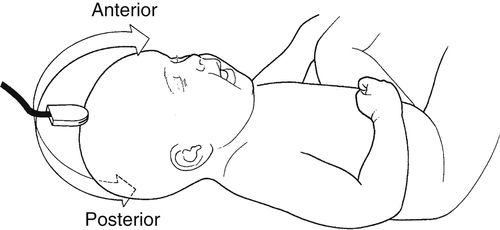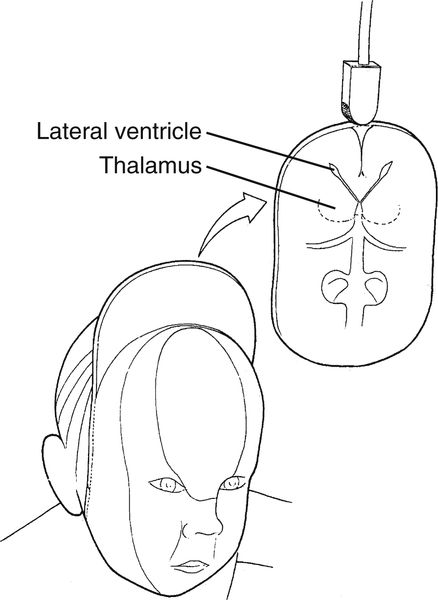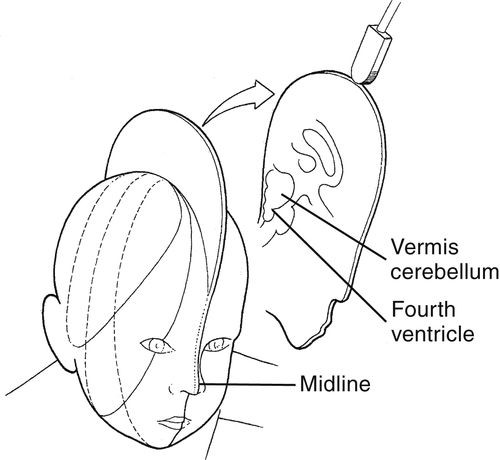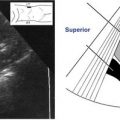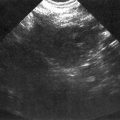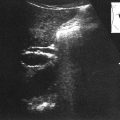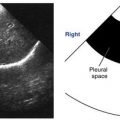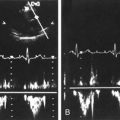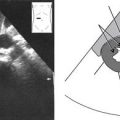Overview
Cranial Vault Anatomy and Sonographic Appearance
• Four ventricles
• Two lateral ventricles
▪ Anatomy: Cerebrospinal fluid-filled cavities within each cerebral hemisphere. Cerebrospinal fluid (CSF) is a clear liquid produced continuously in the ventricles that continually circulates through the ventricles and subarachnoid space to distribute nutrients and to serve as a shock absorber against injury for the brain and spinal cord. Each ventricle is divided segmentally into a frontal horn, body, occipital horn, and temporal horn. The atrium or trigone is the junction of the body and occipital and temporal horns.
▪ Sonographic appearance: The ventricle walls appear echogenic and curvilinear. These slit-like structures lie the same distance from the interhemispheric fissure. The ventricle cavities contain CSF and appear anechoic.
• Third ventricle
▪ Anatomy: The third ventricle is a small, teardrop-shaped, midline cavity that lies between the thalami and is connected to the lateral ventricles via the foramen of Monro (midline channels that mark the communication between the lateral ventricles and third ventricle).
▪ Sonographic appearance: Walls appear echogenic. The cavity contains CSF and appears anechoic.
• Fourth ventricle
▪ Anatomy: A small, thin, arrowhead-shaped, midline cavity that appears to project into the cerebellum. It is vaguely seen except with massive ventricular dilatation. It is located below and connected to the third ventricle by a small channel, the aqueduct of Sylvius, a narrow opening for the passage of CSF. It directs CSF into the subarachnoid space through the foramen of Magendie and foramina of Lushka, three small holes in the floor of the fourth ventricle.
▪ Sonographic appearance: Walls appear echogenic. The cavity contains CSF and appears anechoic when seen.
• Corpus callosum
• Anatomy: Flat, broad nerve fibers between the right and left cerebral hemispheres that form the roof of the lateral ventricles.
• Sonographic appearance: The parenchyma appears midgray or as medium-level echoes.
• Cerebrum
• Anatomy: The largest part of the brain that is divided into two identical, symmetrical right and left hemispheres that communicate through the corpus callosum and are separated from each other at the midline by a deep groove, the interhemispheric fissure. Each cerebral hemisphere is divided into four lobes, named after the overlying cranial bones:
▪ Frontal lobe
▪ Parietal lobe
▪ Temporal lobe
▪ Occipital lobe
• Sonographic appearance: Midgray with medium-level echoes.
• Cavum septum pellucidum (anterior portion) and cavum vergae (posterior portion)
• Anatomy: Small cavities filled with CSF that filters from the ventricles through the septal laminae. They have no connection with the ventricles. They separate the frontal horns of the lateral ventricles, forming their medial margins at the midline of the brain. They close before birth.
• Sonographic appearance: Appear moderately gray and comma-shaped sagittally or triangular coronally.
• Thalamus
• Anatomy: Two large, egg-shaped thalami lie on each side of the third ventricle, forming most of its lateral walls.
• Sonographic appearance: Homogeneous and midgray with medium-level echoes.
• Cerebellum
• Anatomy: Constitutes the second-largest portion of the brain, it lies immediately posterior to the fourth ventricle and occupies the majority of the posterior fossae of the skull. Composed of symmetrical, bilateral hemispheres connected by the vermis, its medial portion.
• Sonographic appearance: parenchyma appears midgray or as medium-level echoes. The central echogenic portion of the cerebellum is the vermis.
• Cisterna magna
• Anatomy: Largest expanded subarachnoid space in the brain. Located at the base of the cerebellum in the posterior portion of the brain.
• Sonographic appearance: The cavity contains CSF and appears anechoic.
• Choroid plexus
• Anatomy: Special blood vessels located in the ventricles that produce CSF.
• Sonographic appearance: Consists of two curvilinear, highly echogenic structures that arch around the thalami anteriorly from the floor of the body of the lateral ventricle and posteriorly to the tip of the temporal horn. Note that the choroid plexus does not extend into the frontal or occipital horns.
• Aqueduct of Sylvius
• Anatomy: Midline channel that connects the third and fourth ventricles.
• Sonographic appearance: Rarely seen sonographically unless dilated.
• Foramen of Monro
• Anatomy: Narrow, midline channels that connect the third ventricle with each lateral ventricle for the passage of CSF.
• Sonographic appearance: Anechoic area just posterior to the level of the frontal horn of each lateral ventricle.
• Brain stem
• Anatomy: Columnar-appearing structure that connects the forebrain and the spinal cord. Consists of the midbrain, pons, and the medulla oblongata.
• Sonographic appearance: Midgray with medium- to low-level echoes.
• Interhemispheric fissure
• Anatomy: Deep groove or indentation separating the right and left cerebral hemispheres. Contains the falx cerebri (fold of the dura mater).
• Sonographic appearance: Thin, linear, echogenic, midline structure.
• Massa intermedia
• Anatomy: Pea-shaped, soft tissue structure that is suspended within the third ventricle with no known function.
• Sonographic appearance: Midgray with medium-level echoes and is best seen with ventricular dilatation.
• Hippocampal gyrus (choroidal fissure)
• Anatomy: Convolution on the inner surface of the temporal lobe of the cerebrum.
• Sonographic appearance: Echogenic, spiral-like fold embodying each temporal horn.
• Cerebral peduncle
• Anatomy: Y-shaped structure inferior to the thalami and fused at the level of the pons.
• Sonographic appearance: Midgray with low-level echoes.
• Sulci
• Anatomy: Grooves separating the gyri on the surface of the brain.
Stay updated, free articles. Join our Telegram channel

Full access? Get Clinical Tree


